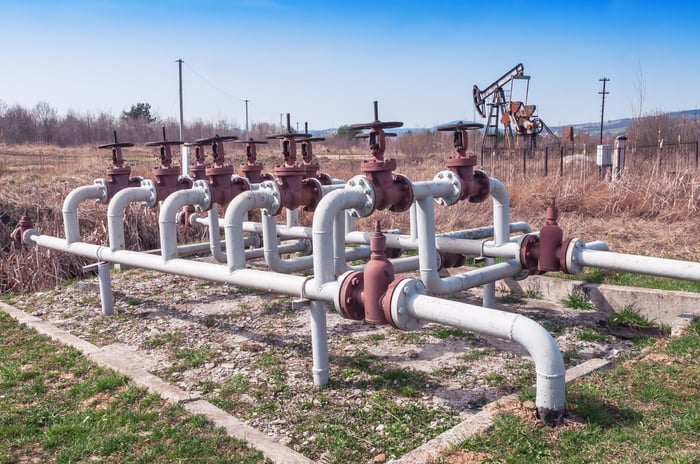Energy Transfer Partners (ETP) is among the highest yielding companies in the MLP space at nearly 13%. That's mainly due to the market's fears that the company's distribution isn't sustainable because of its weaker financial metrics. While those numbers have improved in recent quarters, they still have a way to go.
Three areas in particular stand out as those that need to show continued improvement when the company reports its first-quarter results later this week.

Image source: Getty Images.
Check out the distribution coverage ratio
One reason investors are worried that Energy Transfer might need to reduce its distribution is that the company barely generates enough cash flow to support it without the help of its parent Energy Transfer Equity (ET 1.97%). In 2017, Energy Transfer Partners produced $4.19 billion in distributable cash flow and would have paid out $4.15 billion to investors if it wasn't for the fact that Energy Transfer Equity relinquished its rights to $656 million of that cash. While that support boosted the distribution coverage ratio from a tight 1.0 times to a more comfortable 1.2 times, it was only a temporary fix since Energy Transfer Equity's support will diminish significantly in 2018 before declining further in 2019 and 2020.
On a more positive note, Energy Transfer Partners' coverage ratio was a much stronger 1.3 times in the fourth quarter of 2017, including 1.09 times after adjusting for Energy Transfer Equity's support. A further improvement in that number during the first quarter would show that the company can adequately support its current payout level with cash flow.
See if the leverage ratio improved
Another reason why investors remain concerned about the long-term sustainability of Energy Transfer Partners' distribution is due to its elevated debt level. At the beginning of last year, Energy Transfer's debt-to-adjusted EBITDA stood at a concerning 5.54 times. However, thanks to a combination of asset sales, equity issuances, and incremental earnings from expansion projects, that number had improved to 4.27 times by year-end.
Energy Transfer aims to get that number down to a more comfortable 4.0 times this year. Given that goal, investors should see how close it came to that target in the first quarter.

Image source: Getty Images.
Look for more clarity on the long-term funding situation
Energy Transfers Partners is in the midst of a major expansion phase that will see the company invest $10 billion into projects that should come online through the middle of next year. Funding those growth projects has been a challenge given the company's tight coverage ratio and elevated leverage metrics. However, the pipeline giant has managed to stay out in front of these needs by creatively financing projects through joint venture transactions, asset sales, and other outside-the-box transactions. In fact, it has pre-funded the majority of its capital needs in 2018.
The concern, however, remains on whether Energy Transfer can continue finding creative ways to access the capital it needs to fund expansion projects without resorting to reducing the distribution or issuing more equity when its valuation remains depressed. Because of that, the company needs to develop a long-term funding solution to help improve investor confidence in the distribution.
Fellow MLP Enterprise Products Partners (EPD 0.18%) provided one potential roadmap when it announced that it would slow the pace of its distribution rate growth through the end of this year to increase its retained cash flow going forward. That strategy will enable Enterprise Products Partners to self-fund the equity portion of a $2.5 billion annual investment program (or about $1.25 billion assuming a 50-50 debt and equity split) by next year. By eliminating the need to secure equity financing for a significant portion of its capital spending going forward, Enterprise Products Partners made it less likely that a shift in market conditions will impact its ability to pay its distribution to investors while still growing its business. If Energy Transfer hints that it's considering a similar strategy, it will help reduce investor concerns about the company's ability to meet its long-term funding needs while still paying a lucrative distribution to investors.
Watch for more evidence that a turnaround is under way
While investors have concerns about the long-term sustainability of Energy Transfer Partners' distribution due to its weaker financial situation, those numbers have started turning around in recent quarters. The hope is that they continued heading in the right direction during the first quarter. That would help lift some of the weight that has been holding down the company's valuation, which pushed its yield to its current sky-high level.





